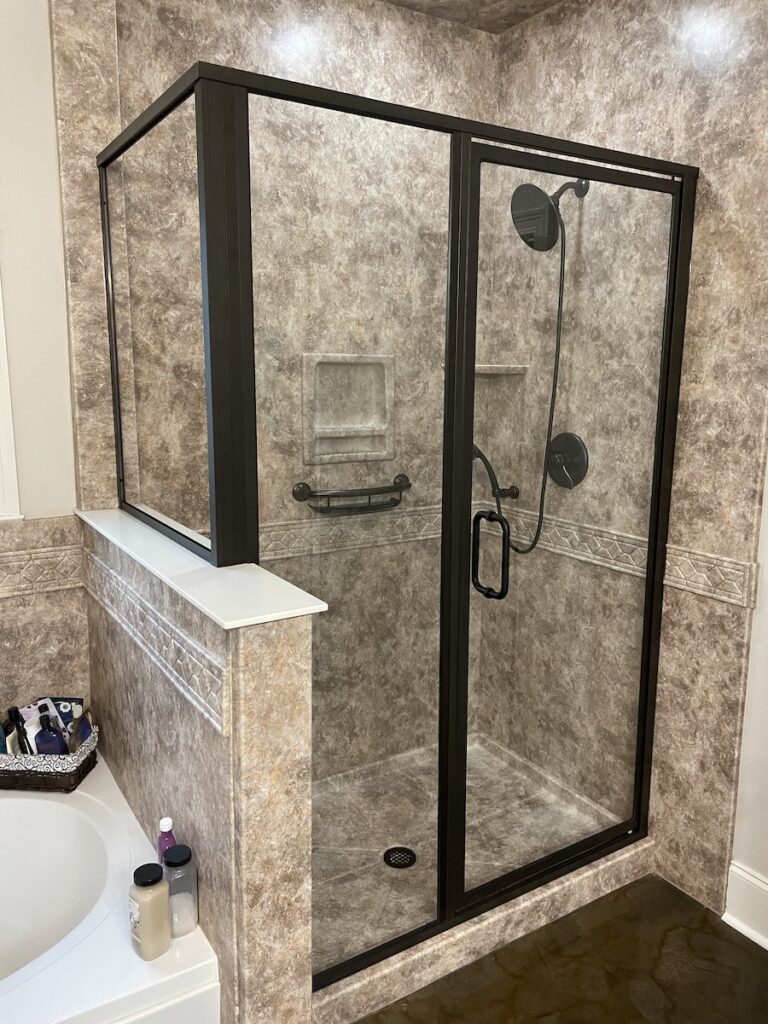Planning a bathroom renovation can be an exciting endeavor. Yet, it’s often accompanied by a lot of questions and decisions to make.
One common question is: how much does it cost to install a walk-in shower? This question is not as straightforward as it may seem.
The cost of installing a walk-in shower can vary greatly. It depends on factors such as the size, materials used, and whether you opt for a DIY or professional installation. Take a look below for a perfect example. The size of the shower glass , shower hardware and overall design are very different.


There is no standard “price range”, however, we will provide a comprehensive guide to walk-in shower installation costs. We’ll get into the various factors that influence these costs and offer insights into managing your renovation budget.
Whether you’re a homeowner, a DIY enthusiast, or simply planning a bathroom makeover, this guide will help you navigate the financial aspects of installing a walk-in shower.
Let’s dive in and explore the costs associated with this popular bathroom upgrade.
Understanding Walk-In Shower Installation Costs
When it comes to installing a walk-in shower, costs can vary widely. On average, homeowners can expect to spend between $1,200 and $5,500. However, this is a broad range. Over our 40+ years of serving South Louisiana, our team of expert glass installers have installed glass showers with price tags upwards of $25,000!
For instance, a simple, prefabricated unit can be on the lower end of the cost spectrum. While a custom-built, luxury walk-in shower with high-end materials and features can easily exceed the average range.
Here’s a rough breakdown of the potential costs involved:
- Prefabricated units: $1,000 – $2,000
- Custom units: $2,500 – $10,000+
- Labor costs: $500 – $1,600+
- Additional costs (plumbing, electrical, permits): Variable
Remember, these are just estimates. The actual cost can vary based on your specific project design, complexity and your location. We always recommend getting multiple quotes to compare products and price. We have to mention, quotes are rarely “apples to apples”. When comparing quotes, ask about the products being used, warantees, and if needed, always request another quote to compare true “apples to apples”.
Factors Influencing the Cost of Walk-In Showers
The cost of installing a walk-in shower is not a fixed figure. It can fluctuate based on several factors. Understanding these factors can help you plan your budget more effectively.
Here are some of the key factors that can influence the cost of your walk-in shower installation:
- Size and dimensions of the shower
- Choice between prefabricated units and custom designs
- Material choices and features
- Labor costs, including the choice between DIY and professional installation
Size and Dimensions
The size and dimensions of your walk-in shower can significantly impact the cost. Larger showers require more materials, which can increase the overall cost.
On the other hand, smaller showers may require less material, but the installation process can be more intricate, affecting the labor cost. Here is another example


Prefabricated Units vs. Custom Designs
Prefabricated units are generally more affordable than custom designs. They come in standard sizes and designs, which simplifies the installation process.
However, custom designs offer more flexibility and personalization. They can be tailored to fit your specific needs and preferences, but this comes at a higher cost.
Material Choices and Features
The materials you choose for your walk-in shower can also affect the cost. For instance, ceramic tiles are typically less expensive than natural stone or glass tiles.
Additionally, the cost can increase if you opt for luxury features, such as multiple showerheads, built-in seating, or high-end fixtures.
Labor: DIY vs. Professional Installation
Labor is another significant factor in the cost of installing a walk-in shower. Hiring professionals can ensure a high-quality installation, but it comes at a price.
On the other hand, a DIY installation can save money, but it requires time, effort, and a certain level of skill. It’s important to weigh the pros and cons of each option.
Additional Costs to Consider
When budgeting for a walk-in shower installation, it’s crucial to consider additional costs. These can significantly impact your overall budget.
Here are some additional costs you may need to factor in:
- Plumbing and electrical work
- Demolition and removal of existing fixtures
- Permits and adherence to building codes
Plumbing and Electrical Work
Plumbing and electrical work can add to the cost of your walk-in shower installation. If your existing plumbing or wiring needs to be updated or moved, this can increase the cost.
It’s also important to consider the cost of installing new fixtures, such as showerheads and lighting.
Demolition and Removal
Before installing a new walk-in shower, the existing shower or bathtub may need to be removed. This process can involve demolition work, which adds to the cost.
Additionally, the removal and disposal of old fixtures and materials can also incur charges.
Permits and Building Codes
Depending on your location, you may need to obtain permits for your bathroom renovation. This can add to the overall cost of the project.
Additionally, your new walk-in shower will need to adhere to local building codes, which may require additional work and materials.
Saving on Your Walk-In Shower
When to Consider DIY
If you’re handy, consider doing some tasks yourself. Simple tasks like painting or installing fixtures can be done without professional help.
However, for complex tasks like heavy glass installation, plumbing and electrical work, it’s best to hire a professional to ensure safety and quality.
Remember, the goal is not just to create a beautiful bathroom, but also to increase the value and functionality of your home.